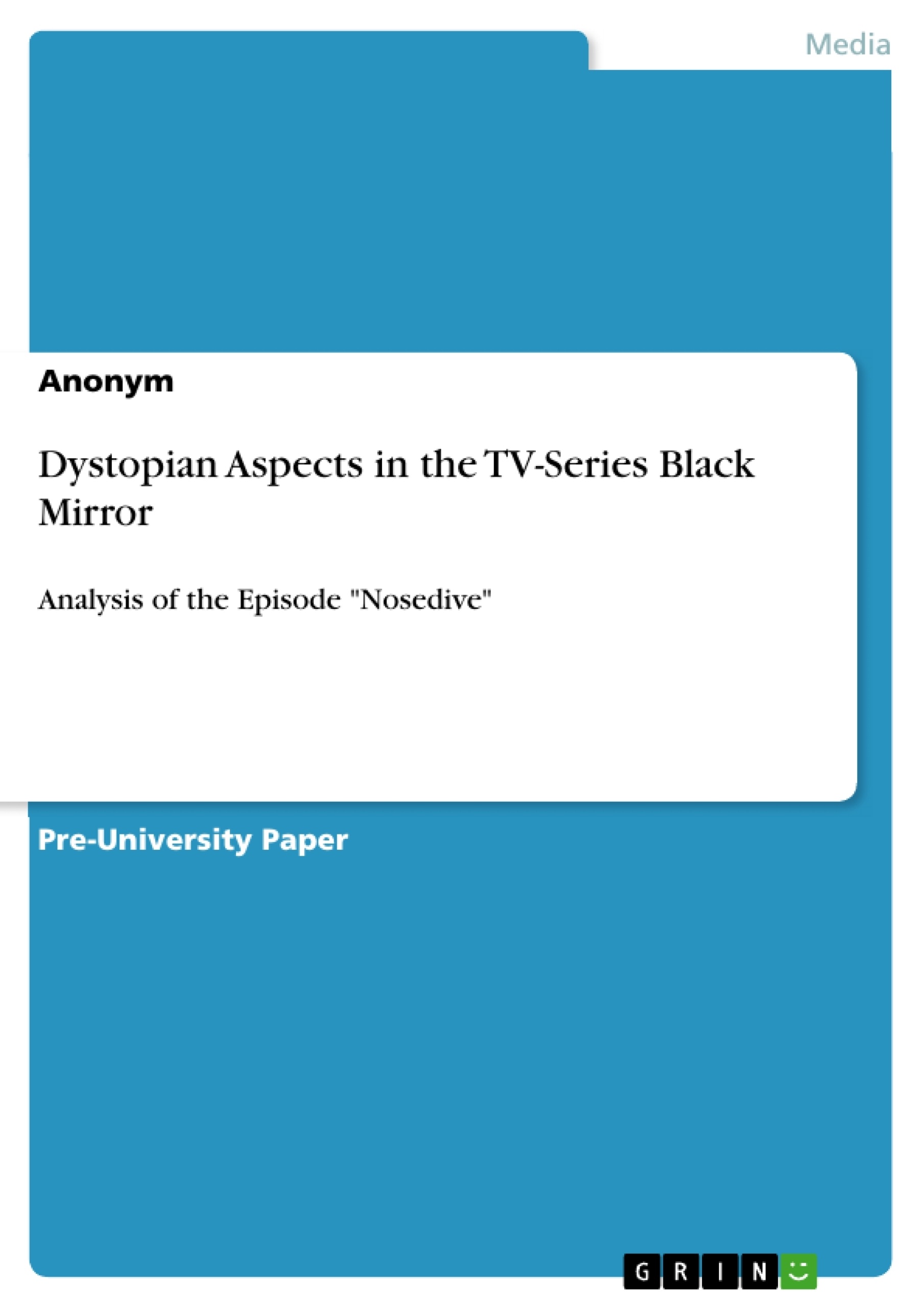In this essay the author talks about the dystopian show "Black Mirror" and analyzes the episode "Nosedive".
We live in a society with a constant, seemingly positive, technological growth. But what if we lose control over what we are creating? That's what dystopian stories are about.
Table of Contents
- 1. Introduction
- 1.1 Utopia and dystopia defined
- 1.2 Black Mirror In General
- 2 Black Mirror - Nosedive Summary And Facts
- 3 Analysis
- 3.1 Fake Impressions
- 3.2 Mob Mentality & Social Inequality
- 3.3 The Hedonic Treadmill
- 4 Conclusion
Objectives and Key Themes
The objective of this essay is to analyze the dystopian aspects of the Black Mirror episode "Nosedive." It explores how the episode critiques societal trends and potential negative consequences of unchecked technological advancement. The analysis focuses on the episode's portrayal of a society obsessed with social ratings and its impact on individual behavior and social structures.
- The dangers of a society obsessed with social ratings and superficial interactions.
- The impact of technology on human connection and authenticity.
- The amplification of social inequalities through technological systems.
- The psychological effects of constant social pressure and judgment.
- The exploration of the nature of happiness and fulfillment in a technologically advanced society.
Chapter Summaries
1. Introduction: This introductory chapter sets the stage for the essay by defining utopia and dystopia, contrasting ideal societies with their dystopian counterparts. It introduces the Black Mirror series as a vehicle for social critique, highlighting its exploration of technological anxieties and potential societal pitfalls. The chapter then specifically introduces the "Nosedive" episode as a case study of these anxieties, foreshadowing the analysis to follow. The author's personal connection to the series and their interest in the episode's predictive nature regarding China's social credit system are also established.
1.1 Utopia and dystopia defined: This section provides concise definitions of utopia and dystopia, tracing the historical shift in societal perspectives on technological progress from optimistic to pessimistic views. It contrasts the characteristics of utopian societies (peaceful governments, equality, access to resources) with those of dystopias (oppressive governments, social inequality, suppression of free thought). Two types of dystopian societies are distinguished: openly repressive systems and seemingly perfect societies masking underlying control and manipulation.
1.2 Black Mirror In General: This section offers background information on the Black Mirror series, its creator, and its overall thematic concerns. It describes the show's format, setting, and tone, emphasizing its use of dark satire to critique modern society and its technological development. The author quotes Charlie Brooker's description of the show's aims, further solidifying its focus on the potential downsides of technology and human clumsiness in navigating its complexities.
2 Black Mirror - Nosedive Summary And Facts: This chapter provides a synopsis of the "Nosedive" episode, outlining the central premise of a society driven by social ratings. It introduces the main character, Lacie, and her struggles to maintain a high rating to achieve social and economic advancement. The chapter outlines the plot's key events, highlighting Lacie's attempts to improve her rating and the escalating consequences of her actions.
Keywords
Black Mirror, Nosedive, dystopia, social rating, technology, social inequality, social pressure, human connection, authenticity, happiness, technological advancement, social credit system.
Black Mirror - Nosedive: A Dystopian Analysis - FAQ
What is the main topic of this document?
This document is a comprehensive analysis of the Black Mirror episode "Nosedive," focusing on its dystopian elements and critique of societal trends related to technology and social ratings. It examines themes of social inequality, the impact of technology on human connection, and the psychological effects of constant social pressure.
What does the document include?
The document includes a table of contents, objectives and key themes, chapter summaries, and keywords. It provides a detailed overview of the "Nosedive" episode, defines utopia and dystopia, and explores the broader context of the Black Mirror series as a vehicle for social commentary.
What are the key themes explored in the analysis of "Nosedive"?
The analysis explores several key themes, including the dangers of a society obsessed with social ratings, the impact of technology on human connection and authenticity, the amplification of social inequalities through technology, the psychological effects of constant social pressure, and the exploration of happiness and fulfillment in a technologically advanced society.
What is the purpose of the chapter summaries?
The chapter summaries provide concise overviews of each section of the document. They detail the content and purpose of the introduction (including definitions of utopia and dystopia and an overview of Black Mirror), the episode summary, and the analytical sections.
How does the document define utopia and dystopia?
The document defines utopia as an ideal society characterized by peace, equality, and access to resources, and dystopia as its opposite, featuring oppressive governments, social inequality, and suppression of free thought. It also distinguishes between openly repressive and seemingly perfect dystopias that mask underlying control.
What is the significance of the Black Mirror series in this analysis?
The Black Mirror series serves as the framework for the analysis. The episode "Nosedive" is used as a case study to explore the series' broader themes concerning technological anxieties and the potential negative consequences of unchecked technological advancement. The author connects the episode to real-world concerns, such as China's social credit system.
What are the keywords associated with this analysis?
Keywords include: Black Mirror, Nosedive, dystopia, social rating, technology, social inequality, social pressure, human connection, authenticity, happiness, technological advancement, and social credit system.
What is the overall conclusion of the analysis?
While not explicitly stated as a separate conclusion section, the overall conclusion is implied throughout the analysis: The "Nosedive" episode serves as a potent critique of societal trends and the potential negative consequences of unchecked technological advancement, particularly regarding the obsession with social ratings and its impact on individual behavior and social structures.
- Citar trabajo
- Anonym (Autor), 2020, Dystopian Aspects in the TV-Series Black Mirror, Múnich, GRIN Verlag, https://www.grin.com/document/704268



